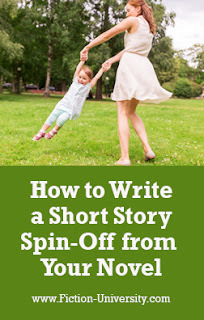Janice Hardy's Blog, page 11
April 17, 2023
Living in My Head: Crafting Natural-Sounding Internal Thoughts
 By Janice Hardy, @Janice_Hardy
By Janice Hardy, @Janice_Hardy How to write tight, third-person internalization that feels natural to the character.
Getting inside a character's head is a key element to getting the reader to care about that character—love them, hate them, fear them, whatever the emotion you want to evoke.
In first person this is easy, because you're already so close to their perspective the thoughts roll naturally into the story. With third person it can be more challenging, because there's an extra layer between the character and the reader. The narrative distance often determines how your internalization will sound.
A close narrative distance will make the internalization feel similar to first person (without the "I" of course). A more distant one will include tags such as he thought. Some will use italics, others will make it part of the narrative. The style is up to you.
((Here's more with Where Do You Want Me? Choosing Narrative Distance in Multiple Third Person).)
Continue ReadingWritten by Janice Hardy. Fiction-University.com
April 13, 2023
Give Your Story Meaning with Inner Conflict and Theme
 By Rayne Hall, @RayneHall
By Rayne Hall, @RayneHallPart of the Focus on Short Fiction Series
JH: No matter the size of your story, a theme can deepen it and make it stronger. Rayne Hall shares tips on finding and developing your story’s theme.
Do you want your story to be meaningful and memorable? Then give it a theme.
Although there are many ways of creating and exploring a theme, here's the one I find the easiest as well as the most powerful.
'One Purpose/Ideal/Value' versus 'Another Purpose/Ideal/Value'.
For example:
Love versus SafetyPatriotism versus FriendshipFaith versus IntegrityHonesty versus CompassionContinue ReadingWritten by Janice Hardy. Fiction-University.com
April 10, 2023
The Real Problem With Passive Voice in Fiction
 By Janice Hardy, @Janice_Hardy
By Janice Hardy, @Janice_HardyPassive voice in a novel can put your readers right to sleep.
Before we dive in, a little heads up that I'm over at Writers in the Storm today, chatting about how to use clichés, metaphors, and similes to bring your story world to life. Come on over and say hello.
And now on to our regularly scheduled article...
“Avoid the passive voice” is one of those pieces of advice most writers have heard and likely struggled with at some point. It’s good advice, since revising passive into active typically makes the sentence stronger, but like all things writing, simply doing it because people say so isn’t always the best idea.
Without understanding why a passive voice causes trouble, you might rewrite it when its actually the best thing for your story at that moment. It does have it’s uses after all.
So first, let's look at what passive voice means.
I used to be one of those folks who wrongly equated passive voice with all forms of the "to be" verb, and I'm guessing I'm not the only one. Because quite often, a “to be” verb is at the heart of a troublesome sentence, but a “to be” verb doesn't always signal passive writing.
April 3, 2023
3 Steps to Crafting a Story Arc that Sucks
 By Janice Hardy, @Janice_Hardy
By Janice Hardy, @Janice_Hardy Sucks readers in…of course.
A novel is a series of smaller story arcs all leading toward “an exciting conclusion,” whatever that may be. These smaller arcs fit together like puzzle pieces and make up the larger plot and story of the novel.
At its most basic, a story arc is the trajectory that a story takes from its beginning to its end. But a well-crafted story arc is much more than that. It's the engine that drives a story forward, the structure that gives it shape, and the journey that takes readers on an emotional roller coaster.
Let's explore the three essential components of a story arc: the beginning, the rising action, and the climax.
Continue ReadingWritten by Janice Hardy. Fiction-University.com
March 30, 2023
Plotting a Short Love Story
 By Rayne Hall, @RayneHall
Part of the Focus on Short Fiction Series
By Rayne Hall, @RayneHall
Part of the Focus on Short Fiction Series
JH: Drawing inspiration from holidays is a great way to spark a new story. Rayne Hall shares 13 tips for writing a Halloween tale.
Readers enjoy short Love Stories in collections, anthologies, magazines, websites. But Love Stories are among the most challenging tales to write.
The Challenge: A Relationship in a Short Space
The challenge is the length. A Romance novel follows the couple as they form a relationship to the level of commitment. How can you do that in the limited space of a short story?Continue ReadingWritten by Janice Hardy. Fiction-University.com
March 27, 2023
How to Make Backstory Work for You
 By Janice Hardy, @Janice_Hardy
By Janice Hardy, @Janice_Hardy
A character's history is important, but not enough to bog down your entire story to hear it.
Along with adverbs and telling, I think backstory completes the unholy trinity of writing. So much so that agent and writing guru Donald Maass advises writers to cut any backstory in the first 50 pages.
But backstory does have its uses, and sometimes, it's critical to know that history.
Even if it's not critical for the reader to know it.
In some genres it's more of an issue. Fantasy, science fiction, historical—any genre where the past and the history of that past strongly affects the current plot and the motivations of the characters. Doubly so if the antagonist is the one with the past that's come back to haunt someone, since you don't always see the antagonist's POV.Continue ReadingWritten by Janice Hardy. Fiction-University.com
March 16, 2023
How to Write a Short Story Spin-Off from Your Novel
 By Rayne Hall, @RayneHall
Part of the Focus on Short Fiction Series
By Rayne Hall, @RayneHall
Part of the Focus on Short Fiction Series
JH: Short stories can be a fantastic marketing tool for your novel. Rayne Hall shows you how to use your novels to create short story spin-offs.
Do you want to create short stories as spin-offs from your novel? This can be a great marketing strategy. When readers who discover your short story on your website or in an anthology and love it, they will look for more fiction by this author. This can strengthen your reputation as an author and boost your novel's sales.
Can you use the novel's main character for spin-off stories?Continue ReadingWritten by Janice Hardy. Fiction-University.com
March 13, 2023
What is “Bad Writing?” (And How Can We Avoid It?)
 By Janice Hardy, @Janice_Hardy
By Janice Hardy, @Janice_Hardy"Bad writing" means different things to different readers.
We writers notice bad writing far more easily than readers, because we know the rules. For us, the writing is critical, but for a reader, it’s more about the story.
Readers don’t care how the sausage is made as long as it tastes good. And “good” is very subjective.
No matter what genre you write, I bet you can name a few huge, mega-bestsellers you feel are badly written. Every genre has them. And they drive us crazy as writers because “writers must write well” is drilled into our heads by everyone in the writing and publishing industry.Continue ReadingWritten by Janice Hardy. Fiction-University.com
March 7, 2023
How to Find Your Character's Voice
 By Janice Hardy
By Janice HardyFinding the right voice for a character can be tough, especially if you’re not sure who that character is yet.
Although a lot of people talk about author voice in fiction, character voice is just as important. It’s also harder, because you only one author voice (usually), but you need multiple character voices in every book you write.
That means knowing the personalities, hopes and dreams, fears and worries, of multiple people, as well as knowing what they’d say or think in any given situation. That’s a lot to figure out.
Luckily, the more you know about a character, the easier it will be to write them. And not just them, the entire novel, too.
Continue ReadingWritten by Janice Hardy. Fiction-University.comFebruary 28, 2023
The 5 Turning Points of a Character Arc
 By Janice Hardy, @Janice_Hardy
By Janice Hardy, @Janice_Hardy
The character arc is a strong tool for adding an emotional layer to a story.
For most novels, the character arc is a critical part of the tale. It’s the emotional layer that makes readers care about all the cool plots and exciting scenes we put before them. Readers enjoy seeing how a character grows, and how they handle the emotional trials of the story.
Just like a plot, the character arc has several turning points that fall at specific structural moments throughout the novel. There’s wiggle room as to where, but they generally fall along the same path as the plot, since the plot is what triggers or impacts these moments.
Continue ReadingWritten by Janice Hardy. Fiction-University.com



